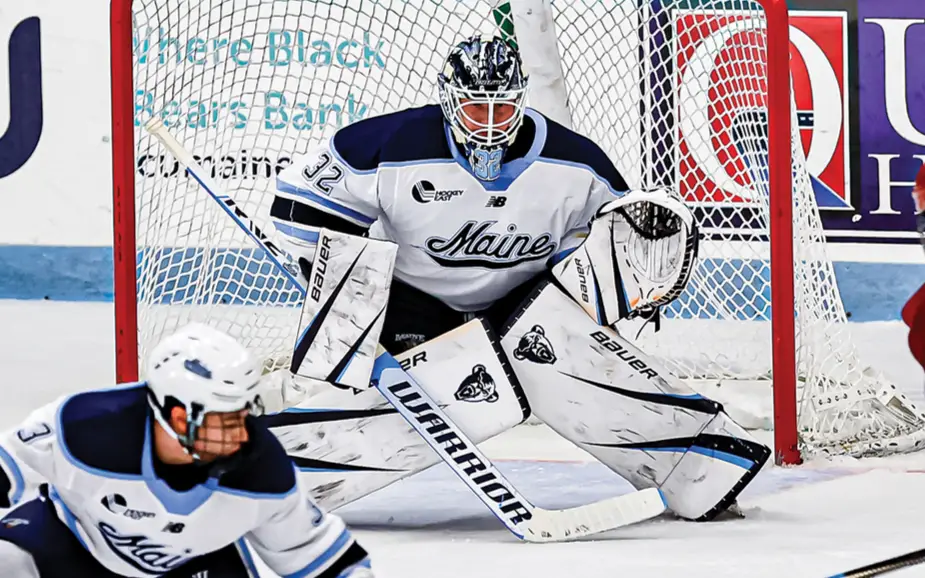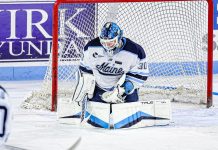
Each week during the season, we look at the big events and big games around Division I men’s college hockey in Tuesday Morning Quarterback.
Paula: Without having played a single game this past weekend, Ed, Wisconsin moves into the top spot of this week’s USCHO.com Men’s D-I Poll with 32 first-place votes.
There are two things that this tells us: Wisconsin has earned the respect of poll voters in a remarkably short span of time at the start of this season, due in large part to the regard that people have for Mike Hastings and his ability to get the most out of any team he coaches.
The second revelation, though, is perhaps how much more poll voters need to see from nearly anyone else near the top whose skates slipped last weekend before giving them the benefit of the doubt.
In voting Wisconsin No. 1, I’d say that voters are taking into consideration the perceived strength of the Big Ten if it weren’t for how much B1G teams fell in this week’s poll. Wisconsin is the only Big Ten team in the top 10.
And Boston College knocked down to fourth place with just two first-place votes and a 7-2-1 record following a weekend against Maine – who catapults to No. 9 – is equally baffling, given the perceived (and very real) strength of Hockey East.
How do we make sense of any of this?
Ed: I agree, Paula, that Wisconsin has earned the respect of poll voters who already had a lot of it for Hastings. Having the weekend off kept any blemishes from the Badgers.
But in a weekend where only five top-20 teams had sweeps, it’s probably more a case of attrition … or a process of elimination. The poll is always a case of “what have you done for me lately” and this week really wasn’t an exception.
(I’ll also note that only one person sees all the ballots and the rest of us just see the results, so there’s no way for us to pick up on patterns or trends from individuals. What do they call that, the “hive mind?”)
I was explaining to someone on Monday about how I approach the poll. USCHO poll voters get a detailed ballot with how each team did over the weekend. I go through each and make some notes as to whether they should go up or down and whether it’s a little or a lot.
I’m also paying attention to what sort of games were played. Did a goaltender stand on his head? Was there a major penalty that made a game look more lopsided?
In this case, you can go down the list of last week’s top teams and see stumbles. You mentioned BC, which had a tough weekend against Maine. That should drop them from No. 1, that is depending on what other teams did. Denver split at Arizona State which kept them from gathering too many first-place votes. Yet Providence’s strong start and weekend sweep garnered them a look and some No. 1 nods.
In the case of Maine, we expected success be coming at this point in Ben Barr’s Black Bears bench boss tenure. And Hockey East as a strong conference is not in doubt, so Maine at No. 9 doesn’t surprise me too much.
I’m interested in your thoughts on Hockey East so far. With six teams in the for-entertainment-purposes-only USCHO poll and six in the meaningless-at-this-point PairWise, is this season portending a better postseason than last for that conference?
Paula: “Ben Barr’s Black Bears bench boss tenure” is a near-perfect headline, Ed, and certainly a great band name. Kudos!
I think that Hockey East had a fantastic season in 2022-23 – a fantastic regular season, that is. For fans, watching several teams within the top to middle of the conference constantly battle it out was very exciting, as was Boston University’s emergence in the second half.
That the conference had a down season in interleague play and that BU couldn’t capitalize on its momentum in the NCAA tournament was disappointing. The conference’s more robust start to 2023-24 is promising, with the league’s .685 win percentage in nonconference play and some really good wins by individual teams over nonleague foes, like Providence’s split with Michigan and win over Denver in October and BU’s split with North Dakota two weeks ago.
If Hockey East continues to play this well out of conference, then the league will have a better chance of placing more teams into the tournament in March. When a conference is so competitive within itself from top to nearly bottom, this nonleague success is essential for postseason play – as we’ve seen from the Big Ten in recent years.
You mention the too-early-to-use PWR, but I do find it interesting to view before the bulk of conference play begins. It echoes some of the in-the-moment stories we’re seeing in the poll, and if you look at them combined I think one of the most interesting stories so far this season is the lack of impact the CCHA is making.
St. Thomas and Minnesota State are the only two CCHA teams with winning overall records, and the league’s nonconference win percentage (.357) bodes poorly for any NCAA tournament success.
Are we looking at an overall picture of three conferences – Hockey East, Big Ten, NCHC – dominant to the point where other leagues are relegated to single representatives next March?
Ed: It’s sure looking that way. Especially since there’s a good chance of at least one independent berth.
Nonconference winning percentage pretty much determines how many teams a conference will get into the NCAAs, and anything below .400 makes more than one team in tenuous at best. If those three conferences got in four teams each – certainly not impossible – then that leaves three autobids and an independent. By the end of the semester break, the bulk of the non-league schedules (except for those independents) will be done and we’ll get a better idea. But the trend is there.
And I find that especially hard to say about ECAC Hockey. I would expect at least two teams from that conference, but a .415 out-of-conference record makes that tough without an upset for the league title – which incidentally happened last year when Colgate beat eventual national champion Quinnipiac. That also kept Alaska out of the tournament.
My one caveat on this is whether the leagues end up cannibalizing themselves. We’ve seen teams that are high in the PairWise also hover at or just below .500 or take conference losses late that bump them just outside the college hockey Mendoza Line of 11th-15th in the PWR.
We can revisit this and how accurate our thoughts were come January when things will start to gel. Over the past few years I think the number is something like 80% of the teams that would make the tournament if the season ended a couple of weeks into the new year will actually be in the tournament.
But getting back to where we started: What’s making it so hard for teams to sweep? Why has winning become so difficult no matter the opponent?
I think you have to say that it’s the abundant level of talent in the sport. I hear some people talk about it being “watered down” with too many teams, but there are a lot more youth programs, more U.S. players, the USA Hockey development model, nutrition, training, and so forth that have made college players of this era incredibly fast, strong, and skilled. Not to mention the number of Americans who thanks to College Hockey Inc. have seen the merits of playing the NCAA instead of major junior north of the border.
When you think back over your 27 years covering college hockey for USCHO – were you 12 when you started? – isn’t it incredible how college hockey has advanced?
Paula: Yes. I was a child prodigy. That’s the only explanation for how long I’ve been doing this.
You hit on two things here, Ed, that I’ve been thinking quite a bit about lately. The first is your response to people who claim that the parity – and I know we both dislike that word, but it applies – in college hockey can somehow be attributed to a diluted talent pool.
Everything you say about that is correct. There’s more talent in college hockey, more advancement in everything that makes the game better, and the emphasis on player development has carried college hockey to an entirely new level. In fact, it gets better every year.
When I first started covering college hockey, I was struck by the difference between the way NBA and NHL announcers talked about players in pro games. In the NBA, mentioning a player’s college was a default. Granted, NCAA basketball has been where NBA talent develops almost exclusively for decades, but even when players came up through the college ranks in hockey, their alma maters were rarely mentioned.
Fast forward to just after the first NHL lockout, when so many older NHL players decided to call it quits, creating a need for bodies on the ice – and opening the door for more NCAA players. Suddenly, the NHL was noticing that NCAA programs were developing solid talent and soon – with the help of College Hockey Inc. and the dedication of many people – the NCAA was on its way to being recognized as legitimate path to the NHL.
Now we’re seeing an emphasis on player development that benefits the young man beyond his potential to play professional hockey. Now we’re seeing a shift in the way in which coaching is approached, to develop the whole person who plays for a team. In addition to being lucrative for all involved, that is an incredibly attractive thing to young players who choose NCAA hockey, sometimes resulting in very elite talent remaining in the game a year or so longer than they otherwise would have a couple of decades ago.
That focus on player development is the best thing that’s happened to college hockey, ever – and it’s a huge reason behind the parity in the game. It’s also great for the potential growth of the sport as more and more kids are playing the game.
The second thing you touch on is my longevity in covering the sport – something that would not have happened were it not for the amazing people I have met and continue to meet through college hockey. We’ve often talked in this column about how college hockey is like a big family, and that really is true. That specific element that defines the sport often pulls people back to it – I’m thinking of Adam Nightingale and Brandan Naurato, but there are others – who bring with them experience from NHL organizations, too.
While all of the developments in college hockey that you define have changed the sport significantly and explain in part the fantastic level of competition we now see, it’s the more recent focus on player development – something so humane – and the communication between the NCAA hockey and the NHL that is really the most amazing thing to me. All of it is good for business. All of it can grow the sport. All of it can lead to better hockey at every level.
Ed: There’s not a lot I can add to what you’ve said, Paula.
As a radio broadcaster, I started to notice the change in the game as my pace had to quicken to keep up with what was happening on the ice. Everybody can skate. Defensemen are fast and skaters are “positionless.” The addition of three-on-three overtime seems to have introduced more of the notion of a possession game and a willingness to step out of the zone and regroup. Power plays have gotten more inventive. Goalies defy physics.
The other part we didn’t mention is video. In-game video analysis between periods, video coordinators watching the game minutely, and individualized clips on players’ phones the morning after the game have revolutionized the personalized coaching and development that’s possible.
Most of what we’ve said about development applies to women’s college hockey where I think the growth has been even more dramatic. (Now if we can only keep a women’s professional league going!)
According to College Hockey Inc., a total of 334 NCAA alumni played in the NHL last season. Half of the NHL’s 32 current general managers played college hockey, as did 13 of the league’s current head coaches.
And we’re adding D-I programs!
The fruit of a lot of effort over the past couple of decades is being harvested right now.


